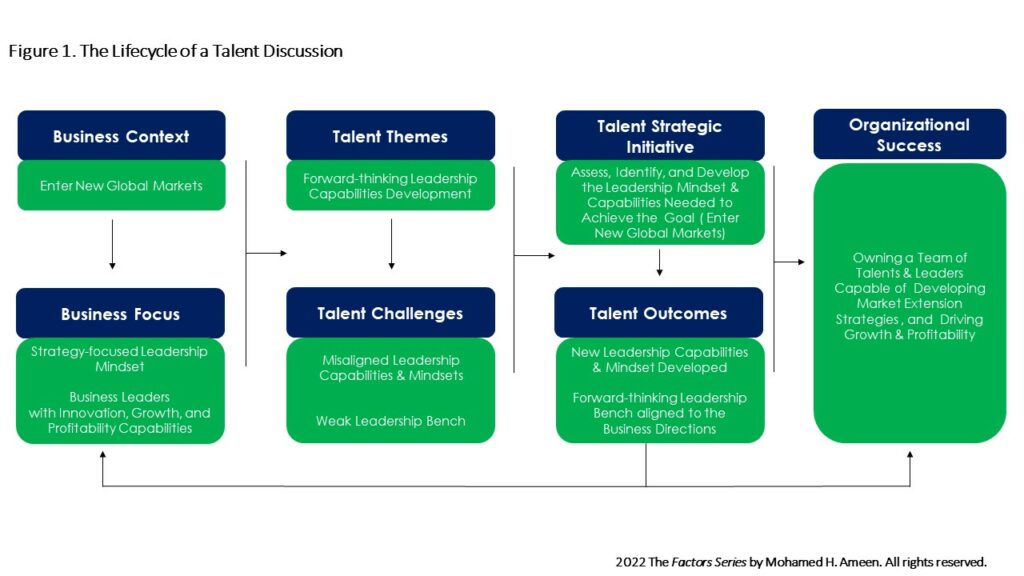Ideally, a talent strategy will address ways the organization must attract, develop, engage and retain talent and drive continuous performance improvement. A more progressive strategy might also address the importance of mobilizing and empowering talent, optimizing the employee experience and improving equity.
However, the focus of executive-level talent discussions must be most on critical talent outcomes (e.g., developing capabilities associated with organizational performance, leadership mindsets and skills associated with business drivers and talent segments associated with organizational future scenarios), not on presenting a talent agenda describing talent management process updates.
Talent discussions must focus on how the talent outcomes have an effective role in delivering the organization’s strategy. Thus, these discussions should be designed to build essential alignment and strong commitment toward the organization’s strategic directions. Talent discussions should focus on the relevance and impact of fueling competitive performance and addressing the organization’s future challenges.
Key elements of executive talent discussions
Executives and business leaders expect a talent discussion that enables them to understand the key promises or outcomes the organization’s talent strategy presents. That’s why a talent discussion is the key stem through which talent leaders should present how the talent strategy is articulated and aligned to the business, and in which ways the talent outcomes impacts the organization’s capabilities.
A best-in-class talent discussion builds upon a clear understanding of the organization’s maturity, the current talent landscape and the organization’s competitive environment. Whether the talent discussion is presented as “a pre- talent strategy discussion” or “a follow-up,” talent leaders should articulate it with a focus on four elements:
- Business drivers and organizational capabilities
Business leaders need to know the “why” behind how talent practices can move the business forward. Business drivers and capabilities are the organizational factors that define the business context. While business drivers represent the most critical priorities of the organization (e.g., enter new global markets, drive profitable growth and cultivate a customer focused culture), capabilities are the DNA of the organization’s ways of performance. They are the factors that have a direct impact of the execution of the strategies, for which the organization is best known and provide a competitive advantage due to being unique and difficult to imitate (e.g., innovation, speed, agility and customer centricity). Since talent strategy is business strategy, your talent discussion should focus on how talent practices contribute toward achieving the organization’s business drivers and foster its capabilities
- Leadership mindsets and behaviors
Having ready and willing leaders capable of fulfilling the organization’s business goals is a competitive advantage and critical for ongoing success. Talent discussions must also focus on building leadership mindsets and behaviors. The talent discussion should reveal two key points on the criticality of leadership as a major talent outcome:
- A business context-based type of leadership shall create a diverse group of ready leaders at all levels who can drive your organization forward now, in the near future and long-term.
- In the current disruptive business climate, organizations have to rethink business models and formulate competitively superior “go-to-market strategies.” This demands leaders to act and respond faster than ever before, anticipating and shaping new futures. As a result, leaders need to be ready for a much wider range of challenges, adapt a specific leadership mindset and learn new skill sets faster than ever before.
- Talent segments and roles
How will the organization differentiate itself from its competitors? And what type of practices will ensure its business continuity? Leaders need answers for the following questions:
- What roles are critical to executing on these capabilities?
- Do we have A Players in these positions?
- Is there succession depth in these roles?
- Where would higher performance levels have the greatest impact on capability?
- What talent constraints are inhibiting our ability to optimize this capability?
Organizations’ talent segments and critical roles represent another critical focus of talent discussions. An effective talent discussion needs to showcase the maturity and health of the talent pools and the extent to which these pools can deliver higher levels of performance and ensure the most critical roles are well managed now and in the future.
- Performance, culture and talent experience
Talent discussions must also focus on culture, new ways of working and the performance scheme which the talent strategy co-creates. Organizational effectiveness is a vital aspect in the organization’s success and it requires creating a talent experience with a focus on the ways of working that enhance delivering the organization’s goals and healthy talent practices.
How should be talent discussions presented?
Talent discussions should always present the focus and outcomes of the talent strategy in relation to the organization’s business context. A successful talent discussion must always enable executives to see the organizational success through key talent promises or outcomes. To do so, your talent discussion should go through six elements (see Figure 1).
Business context: What are the key business drivers, priorities and capabilities the organization capitalizes on in executing its strategic goals and building its future success?
Business focus: What are the key considerations the business should focus on to achieve its business drivers, priorities and capabilities?
Talent themes: What themes could aid the organization in achieving its priorities?
Talent challenges: What are risks the organization might face in achieving its goals?
Talent strategic initiative: What are the talent solutions that could significantly accelerate the organization’s ability to address its drivers and capabilities and deliver its priorities?
Talent outcomes: What are the key talent promises that the talent strategy could deliver to significantly impact the organization’s business drivers, priorities and capabilities?
Organizational success: What type of improvements or achievements can the organization reach due to the talent outcomes?

Business leaders need an effective talent discussion to enable them to understand and agree on the organization’s talent strategy. An effective talent discussion focuses on why we need to invest in specific talent interventions and what type of talent serves the business context and its drivers. Finally, talent leaders should present the talent outcomes/promises as key business promises, not supporting outcomes.
















